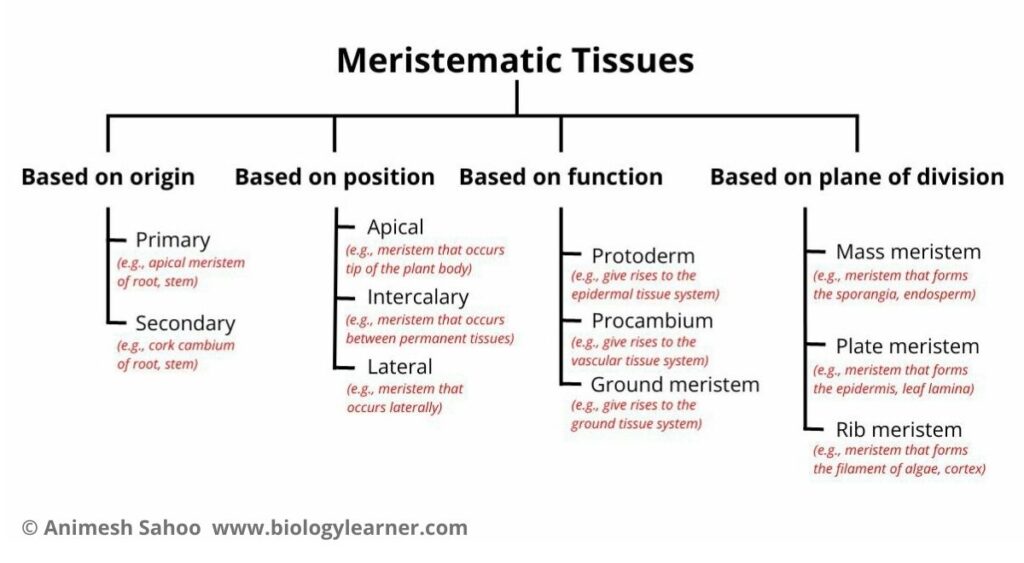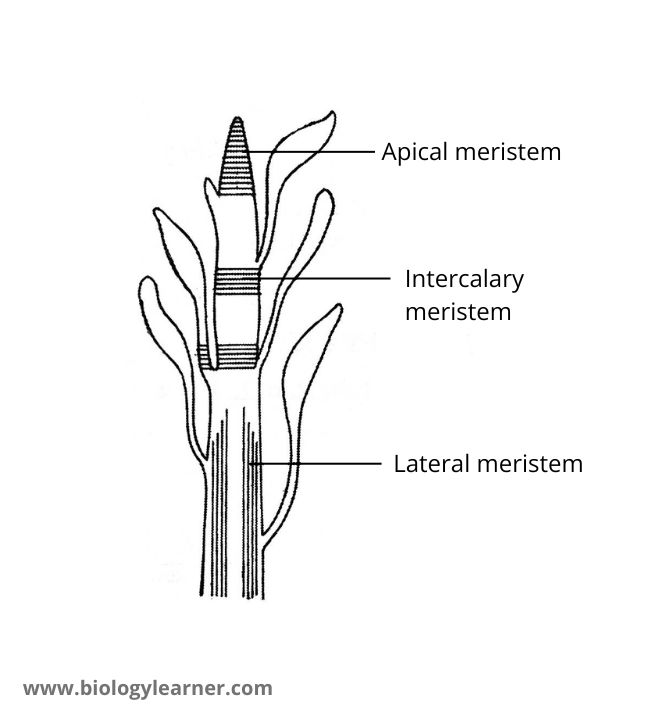Meristematic tissue is a type of plant tissue in which the cells divide continuously and help in plant growth.
The meristematic tissue is also known as a meristem. It is found in areas of the plant where growth occurs, such as the tips of shoots and roots.
The cells of the meristem are called meristematic cells. They are immature, undifferentiated, and capable of cell division.
Meristematic tissues give rise to various permanent tissues in the plant’s body.

Distribution
Meristematic tissues are distributed in the growing regions of the plant, such as the tips of the root, stem, and leaf.
Sometimes meristematic cells remain within the permanent cells. They are also found in the plant organs, where secondary growth occurs. Here, the meristematic cells are distributed towards the periphery.
Characteristics of Meristematic Tissue
- The cells of the meristem are usually small and more or less isodiametric in shape.
- The cells may be rounded, oval, or polygonal.
- They are compactly arranged without any intracellular spaces.
- The cell wall is thin and homogeneous and composed of cellulose.
- Each cell is filled with dense cytoplasm.
- Presence of a large, prominent nucleus in the cell.
- Cells lack ergastic substances (reserve food materials, excretory materials, and secretory materials).
- Generally, vacuoles are not present.
- The plastids are in the proplastid stage.
- The cells are always capable of dividing indefinitely. They divide mitotically.
Types of Meristematic Tissues
Various types of meristematic tissues are found in the plant’s body. They are classified according to their method of development, their origin, their position in the plant body, their function, and their plane of cell division.

Meristematic Tissues Based on the Method of Development and Origin
Based on the origin and the development of initiating cells, meristems are divided into the following three types:
Promeristem or Primordial Meristem
Promeristem is the very foundation stage, the region of the formation of new organs and tissues. It is also known as the early embryonic meristem, from which other advanced meristems are derived.
The cells are small, thin-walled, and immature. Intercellular spaces are absent or minute. They occupy a small area at the tips of the stem and root.
As the cells of the promeristem begin to change in shape, size, and character of the wall and cytoplasm, they have passed the eralist promeristematic condition.
Primary Meristem
The primary meristem originates directly from the embryonic cells. They are present just below the promeristem at the root and shoot apices. The cells remain meristematic throughout the plant’s life.
The primary meristems establish the fundamental i.e., primary part of the plants.
Examples: apical meristem of root, stem, primordia of leaves, and intercalary meristem.
Secondary Meristem
Secondary meristems are those meristems that develop from the permanent cells when these cells regain their power of cell division. They are formed during the secondary growth or the repair of wounds by adding new cells to the primary body.
The secondary meristems produce secondary tissues and help in the secondary growth of plants.
Examples: cork cambium (phellogen), interfascicular cambium of the stem, vascular cambium of the root, wound cambium, accessory cambium, callus tissue that develops during plant tissue culture, etc.
Table: Differences between primary and secondary meristems:
| Sl No. | Primary meristem | Secondary meristem |
| 1. | It originates directly from the embryonic cells of the plant. | It originates from the permanent cells by dedifferentiation. |
| 2. | The cells are usually oval or rectangular, without vacuoles. | The cells are elongated with a large central vacuole. |
| 3. | It forms the primary permanent tissues. | Protoderm, ground tissue, and apical meristems of stem, and root are examples of primary meristems. |
| 4. | Protoderm, ground tissue, and apical meristems of stem, and root are examples of primary meristems. | The cork cambium of the stem and the vascular cambium of the root are examples of secondary meristems. |
Meristematic Tissues Based on Their Position in the Plant Body
According to their position in the plant body, meristems are of three types: apical, intercalary, and lateral.

Apical Meristem
Apical meristem occurs at the tips or growing points of the shoots and roots. It includes the promeristem as well as the primary meristem.
In higher plants, the apical meristem consists of a group of cells called the apical initials or apical cells. Whereas a single cell called the apical cell constitutes the apical meristem in Pteridophytes.
Apical cells divide continuously to increase the length of the plant body.
Intercalary Meristem
The intercalary meristem lies between the permanent tissues. They are the parts of the apical meristems that get separated due to the growth in length of the plant body.
Intercalary meristems are usually found at the base of the leaf (Pinus) and the base of the internode (Grasses and Equisetum). Also, they occur at the base of the node (Mint).
These meristems are short-lived, soon become permanent, and merge with the surrounding tissues.
Lateral Meristem
Lateral meristems occur laterally in the axis, parallel to the surface of the plant body. They consist of one layer of rectangular cells. These cells mainly divide periclinally and give rise to secondary permanent tissues.
The lateral meristem is responsible for the increase in thickness or girth of the plant body.
Examples of lateral meristems are the cambium of vascular bundles and the cork cambium.
Meristematic Tissues Based on Their Function
Based on their function, Haberlandt (1890) classified the primary meristems into protoderm, procambium, and fundamental or ground meristem.
Protoderm
The protoderm is the outermost layer of the apical meristem. The cells are divided periclinally and develop into the epidermal tissue system.
Procambium
It occurs inside the protoderm and gives rise to the vascular tissue system. The cells are narrow and elongated.
In cross-section, the procambium appears as a small group of cells called the procambial strand. These strands are arranged in a ring in the dicot stem. In the monocot stem, they remain scattered. However, in the root, only one procambium strand is present at the center.
Each procambium strand develops into a vascular bundle, consisting of the xylem, phloem, and cambium.
Fundamental or Ground Meristem
The rest of the meristem is the ground meristem. It forms the ground tissue system, which consists of the hypodermis, cortex, endodermis, medullary rays, and pith.
Meristematic Tissues Based on Their Plane of Division
According to the plane of cell division, meristematic tissues are of the following three types:
Mass Meristem
In this type of meristem, cell divisions occur in all possible planes and produce a mass of cells.
Examples: meristems of sporangia, endosperm.
Plate Meristem
In this type of meristem, division occurs mainly anticlinally in two planes, resulting in the formation of a plate-like increase in area.
Examples: meristem of epidermis, leaf blade.
Rib Meristem
Here, division occurs anticlinally in one plane, producing a row of cells.
Examples: meristem that forms algal filament, cortex of young stem.
Functions of Meristematic Tissues
- Cells of meristematic tissue, through active division, help to increase the number of cells and initiate the growth of plant organs.
- It also initiates the development of new organs such as stems, roots, and leaves.
- Meristems are responsible for both the primary and secondary growth of the plants.
- Permanent tissues are developed from the meristematic cells.
- The intercalary meristem can heal the wounds of a plant part.
- Secondary tissues (e.g., cork, wood) are formed by the activities of meristematic cells.
